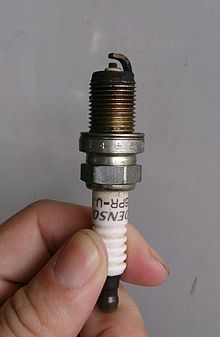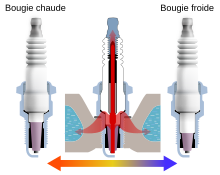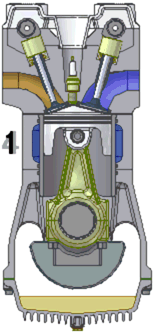Spark plug

The spark plug is the element that produces the ignition of the fuel and oxygen mixture in the cylinders, using a spark, in an internal combustion engine with provoked ignition (MEP), both alternative Otto cycle like the Wankel type. Its correct operation is crucial for the proper development of the combustion-expansion process of the Otto cycle, whether 2-stroke (2T) or 4-stroke (4T) and belongs to the engine's ignition system.
History
Although Nikola Tesla is credited with the first patent for the spark plug, the Serbian inventor registered it with the United States Patents and Trademarks Office (U S Patents & Trademarks Office) in August 1898 It was a complete electrical ignition system, which had a fixed electrode to provide the spark. Richard Simms (GB 24859/1898, 1898) and Robert Bosch (GB 26907/1898) recorded similar more sophisticated devices incorporating replaceable spark plugs. It was the spark plug invented by Robert Bosch engineer Gottlob Honold in 1902, which made the development of internal combustion engines possible.
Operation



The main function of a spark plug is to conduct the electric current generated in the transformer to the combustion chamber and transform it into a high-tension electric spark, which will start combustion, that is, it is an item responsible for the correct burning of the air-fuel mixture.
At the moment the electric spark occurs between the electrodes of the spark plug, the burning of the fuel begins, generating a “sphere of fire”. The “flame front” propagates throughout the combustion chamber, burning the air-fuel mixture and promoting the expansion of the gases.
A spark plug must have the following characteristics:
- Pressure stagnation: despite the different operating conditions it should not allow the passage of gases from the inside of the cylinder to the outside of the cylinder.
- Resistance of insulating material to thermal, mechanical and electrical efforts: it should not be attacked by hydrocarbons and acids formed during combustion. It must maintain its electrical insulation properties without leaving for mechanical requirements.
- Suitable thermal graduation: to ensure the spark plug a correct operation, the temperature of the same location must range from 500 to 600 °C (932 to 1112 °F). The shape of the spark plug and more specifically the length of the ceramic central insulator will give the heat transmission capacity to the bowl, which will determine the stable operating temperature.
The spark plugs convert the electrical energy generated by the ignition coil into an electric arc, which in turn allows the air-fuel mixture to expand rapidly, generating mechanical work that is transmitted to the Wankel-type rotating piston or piston. To do this, a sufficiently high voltage must be supplied to the spark plug by the engine ignition system for the spark to be produced, at least 5000 V. This voltage raising function is done by self-induction in the high electrical voltage coil.
The spark plug tip temperature should be low enough to prevent pre-ignition or detonation, but high enough to prevent carbonization. This is called "thermal performance" and is determined by the thermal range of the spark plug. It is important to keep this in mind, because depending on the type of engine, especially the number of times the spark occurs in the unit of time or engine speed, will determine the operating temperature. The spark plug works as a heat exchanger by removing thermal energy from the combustion chamber and transferring heat out of the combustion chamber to the cylinder head and from there to the engine cooling system. Thermal range is defined as the ability of a spark plug to dissipate heat.
The heat transfer rate is determined by:
- The depth of the insulator;
- Fresh gas flow around the spark plug;
- The construction/materials of the central electrode and porcelain insulation.
Fault analysis

Traditionally, especially before the appearance of electronic ignition and electronic injection, the analysis of the appearance of the spark plug made it possible to determine the operating conditions of the engine, especially the air-fuel mixture ratio, the temperature of operation, etc. Today, electronic ignition systems, the disappearance of the distributor and even the high-tension cables, as well as the millimetric correction of the air-fuel mixture, have minimized disturbances due to the spark plug.
Wet carbonization
When the spark plug has a dark shiny appearance, there are problems with oil passage, which affects the operation of the spark plug since the oil prevents the passage of the spark between the electrodes of the spark plug, causing difficulties in starting.
Causes of carbonization
Typical cases:
- Vehicles with inadequate maintenance,
- Cross bike used to walk.
- Badly chosen or too cold sparks for a high performance engine.
- Use of low octane gas.
Of mechanical origin:
- Against crank pressure.
- Obstructed PCV valve.
- Board of damaged tin.
- Decayed valve guides or retainers.
- Segments of worn pistons.
Consequences if not corrected:
- The engine can be switched off and not rebooted.
- The catalytic converter will be damaged, if you have it.
- You'll consume too much oil.
- Increased emissions of carbon monoxide (CO) and hydrocarbons (HC).
Correct solution:
- If one or more possible causes of mechanical origin are recognized, they must be repaired.
- If it is recognized that there is another cause, the hottest thermal range spark plugs should be installed that are in tune with the operating conditions of the engine.
Dry carbonization
As carbon builds up on the ignition tip, high voltage leakage will occur at the insulator resulting in misfire, causing starting and running difficulties.
Causes of carbonization
- Mix very rich air-fuel.
- Incorrect carburetor adjustment, strangler.
- Defective fuel injection system.
- It's a long minimum.
- Bujía too cold.
Overheating
The surface of the insulator at the ignition tip has a white color with mottled sediments. When the spark plug temperature exceeds 870°C (1598°F), the ignition tip acts as a heat source, igniting the mixture before the spark, thus causing abnormal combustion, occasionally damaging the engine.
Causes of overheating
- Power time too advanced.
- It mixes air-fuels too poor.
- Defective fuel injection system.
- Insufficient cooling water or lubricant.
- The pressure applied to the turbocharger is too high in a turbo engine.
- Insufficient tightening of the spark plug.
- Sediments accumulated in the combustion chamber.
- Bujía too hot.
Lead dirt
It generally appears as a yellowish brown sludge on the insulator. The problem is undetectable at room temperature, but becomes apparent when the spark plug reaches a temperature of 370 to 420°C (698 to 788°F). Since gasoline does not contain anti-knock lead compounds, this deposit no longer occurs.
Deposits
If deposits accumulate on the ignition tip, the spark plug temperature will rise too high and cause pre-ignition, damaging the piston.
Normal wear
Worn electrodes will have difficulty producing sparks, the engine will not show power and will use more fuel, so it will be necessary to install new spark plugs.
Different states of spark plugs
Normal State
Vitrified
Wasted
Incrusted
Engraved
Filled with carbonilla
Durability
Modern spark plugs last around 30,000 to 40,000 km (18,641 to 24,855 miles). In the 1980s, the typical life of spark plugs in car engines was 10,000 to 15,000 km (6,214 to 9,321 miles).
Thermal degree
The thermal rating is the measure of the spark plug's ability to dissipate heat from the combustion chamber to the cylinder head, from where it will be evacuated and, in turn, to the coolant. The thermal rating of a spark plug has no relationship to voltage or operating temperature. The measurement of the thermal degree is determined above all by the length of the free part of the insulator that separates the central electrode from the threaded piece that covers it: the spark plugs are cold if the free part of the insulator is short, since the part that is in contact with the metal piece it transmits more heat; They are hot if that free end is long: the separation makes heat transfer difficult.
The part of the spark plug that is inside the chamber becomes dirty with combustion residues. So that they do not accumulate on the electrodes and end up impairing operation, the temperature of the spark plug must be high enough to burn them. Depending on the engine type, spark plug self-cleaning occurs at 350 to 500°C (662 to 932°F).
On the contrary, if the temperature is too high, the spark plug can become incandescent and start combustion before the spark or pre-ignition occurs. This advance can cause serious damage. To avoid them, a range of 800 to 950 °C (1472 to 1742 °F) should not be exceeded, depending on the engines.
The thermal range is expressed by a code that varies between manufacturers, but as a general rule, a higher number indicates a higher operating temperature, i.e. a hotter spark plug.
Contenido relacionado
Gnus
Transmission electron microscope
Circuit (disambiguation)





